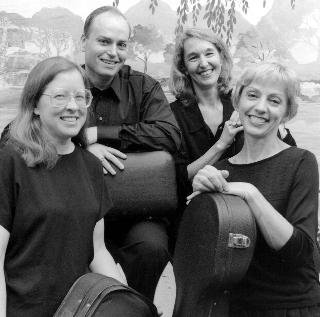Left Bank Octet
| Left Bank at Ionarts: February 28, 2006 May 9, 2005 November 7, 2005 October 20, 2004 |
There was a good reason to attend this concert, the chance to hear a live performance of Mendelssohn's Octet in E-Flat Major, op. 20. It is a piece that you are more likely to hear in an academic setting or played informally at a party of string players. (In an anecdote related by Peter Schickele, at a performance of the Octet in Itzhak Perlman's home where there were only seven music stands, David Finckel placed his music in another player's suspenders and sat behind him.) Mendelssohn was only 16 years old when he composed the Octet, and the mind boggles at the young man's compositional maturity. The piece combines the fruits of a fecund melodic genius with an advanced understanding of the forms of the sonata, enlightened by a daring willingness to stretch them in new directions. The lead-up to the recapitulation in the first movement is so protracted that the tension Mendelssohn creates with repeated false starts is both humorous, as the players exchange knowing glances, and desperate, not unlike trying to find one's way out of a maze. The famous third movement, based on a passage from Goethe's Faust, is a brilliant evocation of a landscape buzzing hazily with insects.
 The spirit of generational combination was embodied by the programming of the first half, a series of more recent pieces for various combinations of two string quartets. Jennifer Higdon's two attempts at writing for string octet, the slow, gentle Quiet Art (2006) and the tango-like To the Point (2004/06), were pretty but a little empty. The remaining three pieces were for the octet instruments grouped by type, each by a composer who played the instrument in question. Violinist turned composer Grażyna Bacewicz's Quartetto per 4 violini (1949) was a rare and often interesting exploration of that unusual grouping. Her style is more tonal than not, with dissonance sometimes employed for effect. The outer fast movements were more effective than the somewhat drab slow movement.
The spirit of generational combination was embodied by the programming of the first half, a series of more recent pieces for various combinations of two string quartets. Jennifer Higdon's two attempts at writing for string octet, the slow, gentle Quiet Art (2006) and the tango-like To the Point (2004/06), were pretty but a little empty. The remaining three pieces were for the octet instruments grouped by type, each by a composer who played the instrument in question. Violinist turned composer Grażyna Bacewicz's Quartetto per 4 violini (1949) was a rare and often interesting exploration of that unusual grouping. Her style is more tonal than not, with dissonance sometimes employed for effect. The outer fast movements were more effective than the somewhat drab slow movement.Least pleasing was a work for two cellos, commissioned by the Left Bank Concert Society from cellist-composer Paul Brantley. The work is probably of extremely recent vintage, since even the Kennedy Center Web site's page for the concert identified it only as "A New Commissioned Work for Two Cellos." Now given the title Mandorla, in tempore belli, the piece has some interesting ideas but sounded not quite fully digested. Certainly it was overshadowed by what came before it, an editorial realization of a movement for two violas by violist-composer Frank Bridge, the most important of Benjamin Britten's teachers. Written for himself and fellow violist Lionel Tertis to play in 1912, the score was lost, but musicologist Paul Hindmarsh has made a version from a detailed sketch of the work, which he calls (without any real justification) Lament for Two Violas. Just how many works in the Bridge corpus are at least part Hindmarsh, anyway? This somber work, structured mostly around an antiphonal dialogue between the two violas, received the finest performance of the first half, by Prof. Katherine Murdock and violin student Gray Dickerson, recently transplanted to viola.
One could imagine a more perfect performance in the details, not surprising considering the players involved, but this concert had all one could hope for in terms of inventive programming. Bravo to the Left Bank Concert Society for bringing this music to their students and giving us the chance to sit in and listen.
The Left Bank Concert Society's next concert, Divas, Tempestuous and Divine, will take place in the Terrace Theater on February 10, 2007, at 7:30 pm.





















































No comments:
Post a Comment